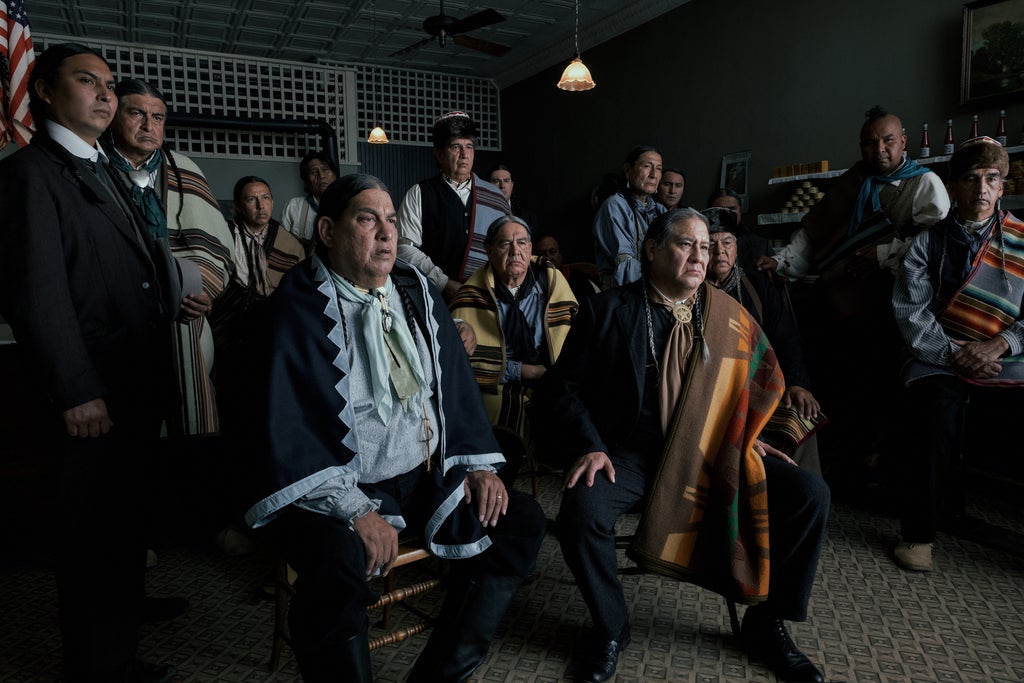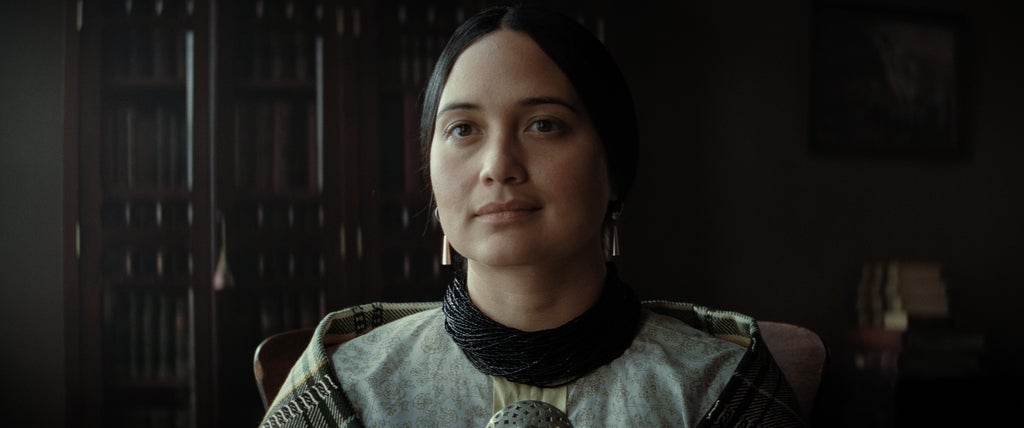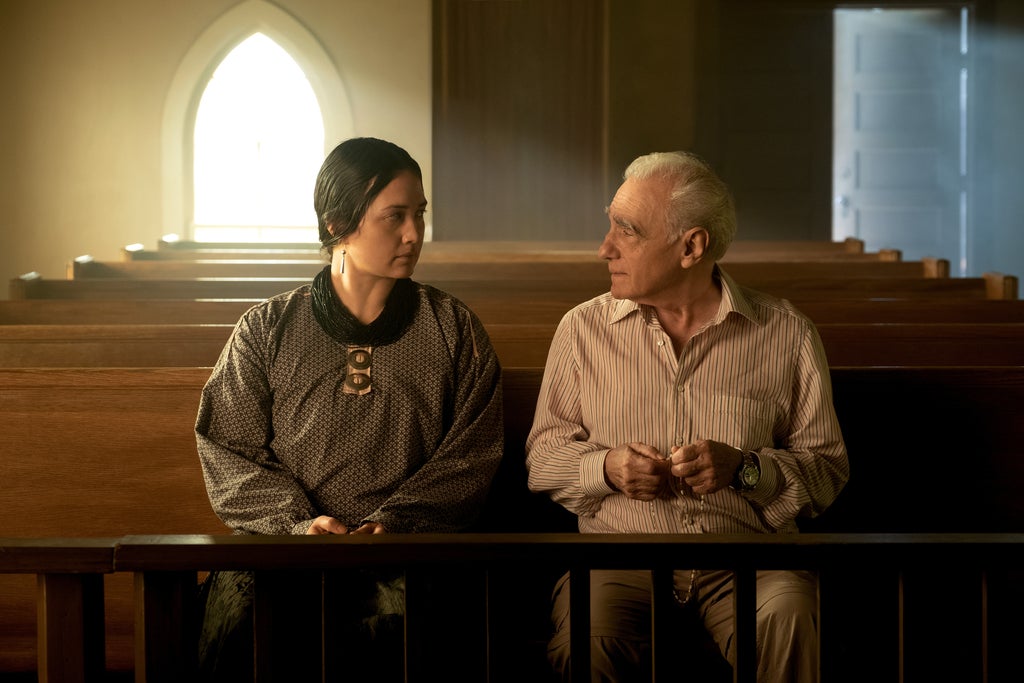Earlier this year, Lily Gladstone made history when she became the first Native American person to win a Golden Globe. Then at the SAG Awards, she did it again. Now, she might just become the first Native American woman to take home an Oscar. But for Gladstone, this recognition shouldn’t be perceived as exceptional or extraordinary.
In an exclusive interview with Refinery29, the Oscar-nominated actress says that her nomination shouldn’t be groundbreaking. “I just hope people realise that we should be everywhere,” Gladstone says, speaking of her Oscar nomination and the recognition of her role as Mollie Kyle in Martin Scorsese’s Killers of the Flower Moon.
“It shows that we’ve been told for so long that our stories are too myopic or too culturally specific, and they’re not going to appeal to a broad audience. It’s just, pardon my language, but bullshit.”
Lily Gladstone
Gladstone’s performance has underscored the importance of diverse and authentic casting in cinema, and she hopes that it will act as proof that Native American voices should be more prevalent in Hollywood. “It shows that we’ve been told for so long that our stories are too myopic or too culturally specific, and they’re not going to appeal to a broad audience. It’s just, pardon my language, but bullshit,” she laughs. “People are really excited to be seeing stories from us.”
Based on a true story, Killers of the Flower Moon features Mollie, an Osage woman who marries Ernest Burkhart (played by Leonardo DiCaprio), only to discover that he’s part of a larger plot to murder members of the Osage Nation in an effort to steal their oil-rich resources.
Her stoic and quietly powerful performance has now earned her an Oscar nomination for Best Actress, where she sits alongside Sandra Hüller (Anatomy of a Fall), Carey Mulligan (Maestro), Annette Bening (Nyad), and perhaps her biggest competition, Emma Stone (Poor Things).
“Native filmmakers deserve the budget that Scorsese is getting.”
Lily Gladstone
While there have been mixed reactions to Killers of the Flower Moon — including its graphic depiction of the very real murders of the Osage people, the centring of and empathy for white characters, and broadly, that the film was directed by Martin Scorsese, a white man — Gladstone says that if Native people aren’t telling their own stories, then the film should be a blueprint in what to do.
“It’s absolutely paramount that we are telling our own stories,” Gladstone explains. “And if we’re not, like in the case of this film, that Native peoples need to be very much in tandem and in every asset, in every department.”
There was a concerted effort to cast Osage and other Indigenous actors in the film, with Osage people being involved at every level of production — from costumes to dialogue. “On this film, there were Osage people in every department on set,” she continues. “So there was never this pressure on us.”
Being of Siksikaitsitapi and Niimiipuu heritage, Gladstone is Native American but not Osage, and explains that she also leaned on the Osage people as a resource to ensure that her performance honoured the real-life Mollie. “You know, not being Osage but being Native, I didn’t want to apply my own worldview and perspective to Mollie and her community, and I didn’t want to be tasked with answering questions that I had no place answering,” she says. “It was really an amazing thing that there was always somebody from the community to answer a question.”

Gladstone shares that during filming, there were many different generations of Osage people, which allowed for many different perspectives. “The Elders on set were the ones who had more of the memory of the people from this time,” she explains. “And then some of the younger folks on set were taking up this mantle of language revitalisation work… [and] have the perspective on what our representation is now and where we want it to go.”
“That was lovely,” she continues. “It was having this diversity of thought and opinion within the Osage community, who were guiding and shaping every step of the way, and then seeing and being touched so much by how production responded to that.”
Being surrounded on set by Native people was something Gladstone cherished, and she mentions that during filming, one of the featured Osage extras went around to all the Native American people on set to ask what their tribal affiliations were. “At the end, there were 230 different tribes that were represented in making this movie.”
“That has to be the new precedent,” she says.

Gladstone is extremely aware that when Native American stories are being told, the budget often goes to well-established filmmakers, like Scorsese, making it almost impossible for Natives to truly tell their own stories. “Native filmmakers deserve the budget that Scorsese is getting,” she says.”If stories like this are getting these budgets and they’re only giving it to filmmakers like Martin Scorsese, then it just has to be how these creatives are working. That’s where it feels like the needle can really move.”
Going forward, the Oscar-nominated actress hopes for a world where Native voices aren’t just being platformed — they’re occupying spaces on the screen that don’t just centre their Nativeness. Talking about her new project, The Memory Police (an adaptation of the acclaimed dystopian novel by Yoko Ogawa with Scorsese as executive producer), Gladstone is excited that more Native artists are participating in projects that don’t necessarily focus on their identity.
“We’re incredible artists who occupy a place on screen and have a certain artistic voice that really appeals to people,” Gladstone says of the shift in Native representation. “While there is Native representation in that project because we’re Native, the project’s not centred around conversations about Native American history or taking up this mantle of having to represent that.”
“We get to be artists telling a human story. Playing a character that could be played by anybody, but is going to be made richer and very specific and more dynamic because of who we are,” she says. “I want to see more of that.”
“We just need more of it, because time and time again critically, you’re seeing accolades coming from what Natives are doing in the industry.”
Lily Gladstone
For Gladstone, there are already two television shows that are paving the way in terms of what good Native American representation looks like. “We’ve got these incredible shows that are cropping up now that we haven’t had for a long time,” she says. “Like Reservation Dogs was so groundbreaking.” The show, created by Aotearoa’s Taika Waititi and Native American filmmaker Sterlin Harjo was critically acclaimed for being a “coming-of-age masterpiece” set on a Native American reservation.
Similarly, Gladstone also spotlights Marvel’s new television series Echo, which she says has given Marvel the “shot in the arm it’s needed.” In the series, the character of Maya Lopez is played by the phenomenal Alaqua Cox — a real-life deaf amputee from the Menominee Nation. “It’s incredible to see Echo out right now, where you have Alaqua Cox just leading the series,” she gushes. “You get to see more of her family and her community in that. It’s no surprise to us that the reason people are more excited now is because of what we’re bringing to it.”
“We just need more of it, because time and time again critically, you’re seeing accolades coming from what Natives are doing in the industry,” she says.

While the industry is (slowly) making progress, such as with Gladstone’s nomination, when it comes to the representation of Native American stories on the screen, sadly much is left to be desired. Depictions of Native Americans on screen have historically oscillated between playing into harmful stereotypes in old Hollywood Westerns, to portraying them as one-dimensional spiritual beings that are connected to the earth (à la Pocahontas). Casting non-Native actors in Native roles is rife (looking at you, Taylor Lautner), and historically Native languages on screen would be achieved through sound mixing English to be backwards. You don’t need to look far to realise that when it comes to Native American stories — and First Nations stories more broadly — that the entertainment industry has perpetuated a legacy of shallow caricatures and woeful misrepresentation.
The Oscars itself also has a problematic history with Native American voices. In 1973, Sacheen Littlefeather became the first Native American person to take the stage at the Oscars when she rejected the Best Actor award on behalf of Marlon Brando. In the speech, the Apache woman spoke about the poor treatment of Native Americans by the film and television industry, only to be met with booing and years of abuse. Nearly fifty years later in 2022, the president of the Academy gave a formal apology to Littlefeather for the abuse she endured following the speech. But what’s clear is that the industry has always had a problem with platforming Native American voices. And unfortunately, it still does.
While Littlefeather’s legitimacy as a Native American woman was posthumously called into question, she’s not wrong when it comes to her assessment of Hollywood. A 2023 study from the Annenberg Inclusion Initiative found that just one protagonist out of the top 1,600 theatrical films in the last 16 years was Native American. While 1.3 per cent of the real-life American population is Native, they only account for 0.25 per cent of speaking characters — which accounts for just 133 of 62,224 speaking characters. What’s more, only 99 of these 133 Native American movie roles were played by actual Native Americans. “Natives playing Natives — that should just be common, that should be the bare minimum,” Gladstone tells me.
With this in mind, Gladstone’s nomination is even more groundbreaking. While she absolutely shouldn’t be the first Native American actress to be nominated for an Oscar, it does show that the industry is moving in the right direction, even if it might be by only an inch. From Littlefeather being booed on stage, to Gladstone speaking Blackfeet on the Golden Globes and SAG stage and dedicating her award to “every little rez kid”, history is being made — whether Gladstone wins or not.
“Killers of the Flower Moon” is streaming now on Apple TV+.
Like what you see? How about some more R29 goodness, right here?
The Best Red Carpet Looks From The 2024 SAG Awards